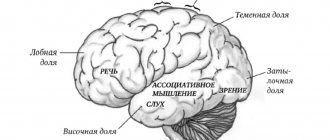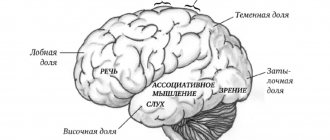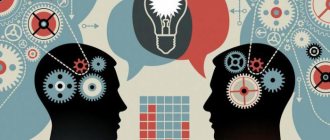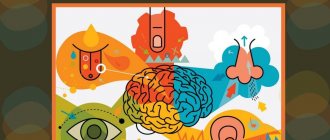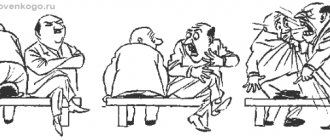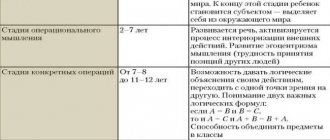Updated July 24, 2021 876 Author: Dmitry Petrov
Hello, dear readers of the KtoNaNovenkogo.ru blog. Today I want to talk about a very interesting thing - a person’s perception of the world around him and other people.
Let's take a look at this process from a psychological point of view to understand its essence. We will find out what properties it has, what types it is divided into, what errors sometimes arise and how a person perceives another person. I hope it will be interesting.
Perception - what is it?
The term "perception" can be considered in two contexts. In one of them:
Perception is the process through which images of the surrounding world are formed, a reflection of reality in the psyche.
In this case, the concept is a verb, that is, an action.
In another context, perception is a noun, an object, a result, an image itself.
Most often, science (what is this?) uses the first version of meanings. We will rely on it in this article.
Perception is synonymous with the word perception, which, in turn, translated from Latin perceptio means subjective, sensory knowledge of the environment. Words such as appreciation, acceptance, contemplation and others are also used equally.
What is perception in simple words? In the process of life, a person does not stop learning about the world. For example, in a store you are interested in some thing: you take it in your hands to understand what its texture, weight, density, color, smell, taste and so on, that is, you use the necessary senses (food - taste, book - vision).
All these characteristics cause different sensations, which together give rise to the image of the object. The process of cognition, therefore, is perception.
It is important to note that perception in psychology is not just the sum of sensations. It also includes our individual knowledge and beliefs about the world. This phenomenon is closely related to other mental processes: memory, thinking, speech, motivational sphere and attention.
The illusion of reality
The illusion of perception occurs when reality is reflected distortedly, while the effect is sustainable. Illusions can occur in many people under the influence of physical, physiological and psychological reasons.
The breaking of a spoon in a glass of tea is classified as a physical illusion, and the splitting of the image when pressing sideways on the eyeball is considered a physiological illusion. A psychological illusion occurs when identical lines are overestimated up or down when their lengths are objectively equal.
Another example considers overvaluing the top parts of the figure. When dividing a vertical line in half, a person often makes the mistake of setting the middle much higher than the real one.
Properties of perception
It is customary to distinguish 7 properties of perception:
- Selectivity is the preferential selection of one object against the background of others due to the impossibility of embracing a large number of them at the same time.
In a bookstore, you will sort through books one by one to decide which one is worth buying for further reading. When you have a specific one in your hands, at that moment all attention is focused on it: the reader examines it externally, reads the title, content, and skims through it. The rest seem to not exist, fade into the background. But as soon as interest in this publication disappears, attention moves to the next one. What was in the hands fades into the background. - Objectivity of perception – represents the assignment of an object to a certain category of environmental objects. For example, green, round, hard and sweet is an apple, a fruit, and green, long and growls is a crocodile, an animal.
Often the recognition process does not occur immediately: a person is forced to spend some time and additional effort to determine the type of object being studied (come closer, listen or smell).Recognition also divided into specific and nonspecific: the first is what is familiar to us (on the street I recognize my husband’s car). The second type helps to determine only the type of object, its superficial characteristics (on the street I see a lot of moving objects and identify them as cars, but I don’t know whose they are, their year of manufacture, history, etc.).
In this regard, objectivity influences human behavior: if you offer him a familiar scrambled egg for dinner, the latter will be quickly eaten. In the case where we have an unfamiliar product in front of us, the majority will most likely show caution - they will be more closely interested in the proposed dish.
- Apperception is expressed in dependence of image formation on mental experience and personal characteristics of the individual.
Simply put, people perceive the same object differently, based on their beliefs, attitudes, values and needs. The short video below shows this property of human perception in simple pictures that everyone sees differently: - Integrity is a property that demonstrates the fact that an image is always perceived as a whole based on the totality of sensations received from it. That is, it cannot be created by color or sound alone. The important factor here is movement. For example, a frog does not perceive a fly as a fly if it remains motionless, so it will not hunt it.
- Structurality lies in the fact that perception is not the sum of individual sensations.
The image is born only through their interaction. Each element becomes significant when related to the whole. For example, a large, iron thing floating on water is a steamship, a large and iron thing on rails is a train: replacing one element changes the image. Also, when a person listens to music, he does not perceive each note separately: he hears the whole melody. Playing notes in different order and key changes the entire melody. - Constancy is the relative constancy of surrounding objects.
Why relative? During the day, you can clearly see that your house is blue in color, but as night falls, it turns gray. At the same time, you know for sure that the house is yours, since you do not attach importance to the fact of changes in visual perception. If this property did not exist, then with the onset of night, screams of horror and despair would be heard everywhere: people would not recognize their homes, other landmarks would also be lost. - Meaningfulness is the awareness of objects and phenomena of the surrounding world. For example, if we see a spoon, we immediately understand what it is for and how to use it. This confirms the fact that perception is not innate: we learn it throughout life.
Space, time and motion
The interaction and combination of different sensations gives the ability to perceive certain forms of existing matter of time, space and movement. Space is almost always perceived by humans. This includes assessing the presence and position of one's own body. As well as visual reading - direction, distance, shape, depth and volume.
The distance of objects and the location of light and shade are of great importance. The olfactory, auditory, vestibular and other sensory systems are involved in the perception of space.
The perception of time is a very subjective concept, but some patterns are noted. All phenomena in life occur in time. The law of present and past tense is that the more the present is filled with events, the shorter it seems. The waiting periods feel very long.
In memories, the opposite picture is present - an eventful period of time is perceived as longer. Estimation of time is very individual. The assessment is influenced by the nature of the activity, structure and motivation. High interest speeds up the time interval, while low interest slows it down. The personality structure, motives, emotions and age of a person also influence here.
Movement is a reflection of the variability of the location of an object in space; the direction and speed of movement are also taken into account.
There are perceptions:
- according to the form of movement - circular, arc-shaped, straight, etc.;
- vibration amplitude - small, medium and large;
- direction - right, left, up, down;
- by duration - short, long;
- by acceleration and speed - fast, slow, smooth or intermittent;
- by the nature of the movement - flexion, rotation, extension.
Types of perception
The world is huge and diverse: each object or phenomenon is perceived through different receivers or analyzers, one of which is always leading.
When reading printed information, we rely more on vision, when eating - on taste sensations, hugging a person, we perceive him through the body, tactile contact.
There are several classifications of types of perception:
By modality:
- visual – creating a visual image:
- auditory – receptivity to sounds;
- tactile perception – reading information about the environment through tactile sensations;
- olfactory – distinguishing odors;
- gustatory – building an image using taste sensations.
Depending on the host analyzer:
- Simple sight is sight, hearing and touch. All healthy people have this type of perception. Depending on which analyzer a person uses most often, he is classified as a group of people with the corresponding type of perception: kinesthetic (sensations, movement) - a person (he is called a kinesthetic) reads information, relying most on the movement of objects, the sensations that these objects call. In his speech the words “take”, “grasp”, “try”, “feel”, “feel” are constantly heard;
- auditory (sound) - most of the perception of the world occurs through hearing. Such people often say “I hear”, “listen”, “listen”, “sounds” and others;
- visual (vision) – the leading receiver is the eyes: “I see”, “I look”, “I imagine”.
Thus, by listening to how a person speaks, one can calculate his individual type of simple perception. This knowledge will help solve the eternal problem of interaction - the inability to understand each other. The latter occurs precisely because of different abilities to “see” the world.
By updating method:
Perception in psychology can also be voluntary or involuntary . The first necessarily has a goal, intention and awareness of actions. For example, a child reads a book and understands why he is doing it. He directs all his attention to this activity, focuses his vision on the letters, and holds the textbook in his hands.
Involuntary perception is caused by the environment, not by the individual's goals. A striking example: the reaction of the leg to a neurologist’s hammer, with which he hits under the kneecap to check physiological reactions.
PRACTICAL TASK
Correlate the proposed socio-psychological concepts and their definitions:
A) stereotype;
B) prejudice;
- one-sided, distorted and, as a rule, prejudiced view, characteristic of representatives of professional, age, social, ethnic groups or classes;
- personal antipathy or active hostility towards another social group; however, individuals may or may not participate in discriminatory activities based on their views.
ANSWER:
Stereotype - personal antipathy or active hostility towards another social group; however, individuals may or may not participate in discriminatory activities based on their views. For example, death sentences in North America and Europe are more likely to be imposed in regions where the percentage of the population is black. A black American is more likely to be sentenced to extreme punishment than a white American who commits a similar crime. Racial stereotypes among jurors are believed to be one reason for this.
Prejudice is a one-sided, distorted and, as a rule, prejudiced view characteristic of representatives of professional, age, social, ethnic groups or classes. For example, authoritarian people show strong negative emotions, anger, and aggression in accordance with their prejudices. They strictly follow their beliefs and emotions, which often carry a tinge of revenge. For this reason, their prejudices reflect their internal needs more than social norms;
Errors in perception (illusions)
There is nothing perfect in the world, and perception is no exception. For various reasons, this process can “fail” and give the individual erroneous images that do not correspond to reality.
There are two types of such violations:
- illusions are a perverted perception of existing objects and phenomena. Illusions, in turn, are: affectogenic - they are caused by feelings and emotions. For example, an anxious person may see an approaching maniac or monster in the shadow of a tree, hear a threat in someone else’s speech, a shy person will see criticism and shaming everywhere;
- pareidolic - the emergence of fantastic images when interacting with reality (blood in a glass instead of water, beetles instead of dirt stains). This type of illusion is a precursor to hallucinations.
This disorder is independently present only in mentally ill people - psychotics (for example, schizophrenics). The only condition under which a normal person can temporarily see hallucinations is a forced change in mental state (hypnosis, drugs).
Applications of perception research
Knowledge of the laws of aesthetics plays a decisive role in such areas of human activity as art, architecture, design, advertising, food and perfume industries, cinema and the recording industry, etc. The study of the laws of formation of aesthetics is important. B. children and adolescents. A detailed study of the mechanisms of V. disorders as a result of diseases and local brain lesions leading to agnosia, aphasia, deafness, and blindness helps in the development of methods for correcting, enhancing, and prosthetizing human sensory and perceptual capabilities. A large class of applied V. research includes work on modeling V.’s individual characteristics and recognition of faces and emotions. Great practical The creation of multimedia information is important. systems (for example, for the entertainment industry) and virtual reality systems (for example, the development of simulators that simulate virtual reality conditions and actions in special types of professional activities).
Person's perception by person
An interesting picture emerges when it comes to the perception of a person by a person. Interesting because in reality we don’t see each other when we first meet as we really are, and there are many reasons for this.
Have you noticed that when you meet a person who has a pleasant appearance for you, you automatically consider him kind and good? And if he has external similarities with his beloved friend, mother, brother, then sympathy for him increases significantly?
The perception of others is determined by many more factors that we consciously or not pay attention to: posture, gestures, speech culture, manners, behavior, his profession, status and others.
So, there are 4 ways to interpret the characteristics of other people:
- emotional – beautiful, which means good, sincere;
- analytical - frowning eyebrows, sharp cheekbones “characterize” an evil person;
- perceptual-associative - similar to a harmful neighbor, which means just as unpleasant;
- social-associative – attributing social qualities to a person based on appearance. Torn, dirty clothes “tell” us about a dysfunctional personality and makes us want to stay away. But a neat suit and an expensive car elevate a stranger in our eyes.
BIBLIOGRAPHY
- Psychology and ethics of business communication: a textbook for university students / Edited by V.N. Lavrinenko – 5th ed. M.: UNITY-DANA, 2006-415 p.
- Semechkin N.I. Social Psychology. Part 2 https://www.twirpx.com/file/63849/
- Social stereotypes and prejudices https://roman.by/r-23756.html
- Stefanenko T.G. Ethnopsychology. Workshop. - M., 2006 https://psyfactor.org/lib/stereotype8.htm
- Titova L.G. Business communication: Textbook.-M.: UNITY-DANA, 2005-368p.
- Techniques of disinformation and deception. Ed. Ya.N. Zasursky. M., “Thought”, 1978 https://psyfactor.org/lib/stereotype10.htm
- Shikhireev P.N. Modern social psychology https://roman.by/r-23755.htmlWashington
Attention!
If you need help writing a paper, we recommend turning to professionals. More than 70,000 authors are ready to help you right now. Free adjustments and improvements. Find out the cost of your work
Free estimate
+3
Size: 113.35K
Downloads: 131
04/19/11 at 17:37 Author: Feniks
Liked? Click on the button below. It's not difficult for you
, and we
are pleased
).
To download test papers for free at maximum speed, register or log in to the site.
Important! All submitted Tests for free downloading are intended for drawing up a plan or basis for your own scientific works.
Friends! You have a unique opportunity to help students just like you! If our site helped you find the job you need, then you certainly understand how the job you add can make the work of others easier.
Add a job
If the Test work, in your opinion, is of poor quality, or you have already seen this work, please let us know.
Reasons for violations
Under certain circumstances, various disturbances in the mechanisms of perception may occur. These may be mental stress, exposure to chemicals, illness or loss of strength. The most famous include hallucinations - images without the real presence of an object.
Hallucinogenic phenomena occur in any modality:
- visual (through images, various events);
- auditory (sounds, clicks, etc.);
- tactile (skin reactions in the form of sensations of cold, burns, crawling insects).
The area of perception is vast, people see the world in different variations, despite the fact that in theory it is the same for everyone.

